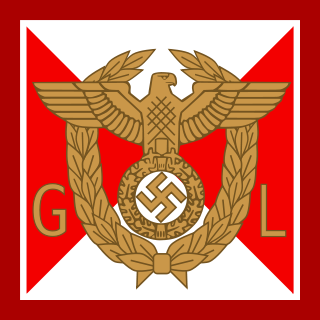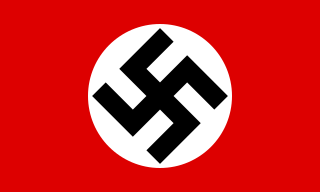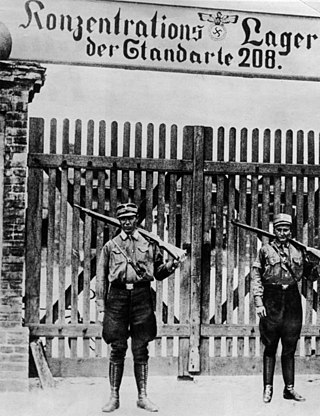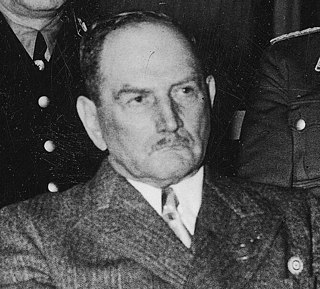Führer is a German word meaning "leader" or "guide". As a political title, it is strongly associated with Adolf Hitler, the dictator of Nazi Germany from 1933 to 1945. Hitler officially styled himself der Führer und Reichskanzler after the death of President Paul von Hindenburg in 1934 and the subsequent merging of the offices of Reichspräsident and Reichskanzler.

A Gauleiter was a regional leader of the Nazi Party (NSDAP) who served as the head of a Gau or Reichsgau. Gauleiter was the third-highest rank in the Nazi political leadership, subordinate only to Reichsleiter and to the Führer himself. The position was effectively abolished with the fall of the Nazi regime on 8 May 1945.

The uniforms and insignia of the Schutzstaffel (SS) served to distinguish its Nazi paramilitary ranks between 1925 and 1945 from the ranks of the Wehrmacht, the German state, and the Nazi Party.

This is a list of words, terms, concepts and slogans of Nazi Germany used in the historiography covering the Nazi regime. Some words were coined by Adolf Hitler and other Nazi Party members. Other words and concepts were borrowed and appropriated, and other terms were already in use during the Weimar Republic. Finally, some are taken from Germany's cultural tradition.

The uniforms and insignia of the Sturmabteilung (SA) were Nazi Party paramilitary ranks and uniforms used by SA stormtroopers from 1921 until the fall of Nazi Germany in 1945. The titles and phrases used by the SA were the basis for paramilitary titles used by several other Nazi paramilitary groups, among them the Schutzstaffel (SS). Early SS ranks were identical to the SA, since the SS was originally considered a sub-organization of the Sturmabteilung.

Blockleiter, where block refers to city block, was from 1933 the title of a lower Nazi Party political rank responsible for the political supervision of a neighborhood. Referred to in common parlance as Blockwart, the Block Warden's duty was to form the primary link between the Nazi authorities and the general population. The derogatory term Blockwart ("snoop") survives in German colloquial language.

Ranks and insignia were used by the National Socialist German Workers' Party (NSDAP) as paramilitary titles between approximately 1928 and the fall of Nazi Germany in 1945. Such ranks were held within the political leadership corps of the Nazi Party, charged with the overseeing of the regular Nazi Party members.
Helfer is a German word which translates as "Helper", and the word was used as a paramilitary rank of the Nazi Party between the years of 1938 and 1945. The Nazi rank of Helfer was a junior position of the Political Leadership Corps, ranking only above Anwärter. A Helfer in the Nazi Party typically served as a junior assistant to a higher official. The rank was created at first to replace the older Nazi rank of Blockleiter; however, a massive expansion of Nazi Party ranks in 1938 assigned the old duties of a Blockleiter to a rank known as Arbeitsleiter. The rank of Helfer then became an assistant position to such higher ranks.

Johann Heinrich "Hans" Hinkel was a journalist, Nazi Party official and politician in Nazi Germany. He mainly worked in the Reich Chamber of Culture and the Reich Ministry of Propaganda. He was involved in executing the policy of excluding Jews from German cultural life, and headed the Ministry's film division. He was also an SS-Gruppenführer, and was imprisoned in Poland for several years after the end of the Second World War.

Franz Ritter von Epp was a German general and politician who started his military career in the Bavarian Army. Successful wartime military service earned him a knighthood in 1916. After the end of World War I and the dissolution of the German Empire, von Epp was a commanding officer in the Freikorps and the Reichswehr. He was a member of Bavarian People's Party, before joining the Nazi Party in 1928, when he was elected as a member of the German parliament or Reichstag, a position he held until the fall of Nazi Germany. He was the Reichskommissar, later Reichsstatthalter, for Bavaria, and a Reichsleiter of the Nazi Party. During the Nazi era, Epp, who'd participated in the Herero and Namaqua genocide as a young man, shared responsibility for the liquidation of virtually all Bavarian Jews and Romas as the governor of Bavaria.

The Gau Munich–Upper Bavaria was an administrative division of Nazi Germany in Upper Bavaria from 1933 to 1945. From 1930 to 1933, it was the regional subdivision of the Nazi Party in that area.

Zellenleiter was a Nazi Party political title which existed between the years of 1930 and 1945. A Zellenleiter was higher in rank than a Blockleiter and was in charge of a "Nazi Cell", composed of eight to twelve city blocks.
Units and commands of the Schutzstaffel were organizational titles used by the SS to describe the many groups, forces, and formations that existed within the SS from its inception in 1923 to the eventual fall of Nazi Germany in 1945.

Ortsgruppenleiter was a Nazi Party political rank and title which existed between 1930 and 1945. The term first came into being during the German elections of 1930, and was held by the head Nazi of a town or city, or in larger cities, of a neighbourhood, for the purposes of election district organization. After 1933, through the process of Gleichschaltung, the position of Ortsgruppenleiter evolved into the Nazi leader of a large town or city or of a city district.

Kreisleiter was a Nazi Party political rank and title which existed as a political rank between 1930 and 1945 and as a Nazi Party title from as early as 1928. The position of Kreisleiter was first formed to provide German election district coordination and, after the Nazi assumption of power, the position became one of county municipal government, effectively replacing the traditional German government establishment.

Dienstleiter was a high-ranking Nazi Party political rank of Nazi Germany which existed between 1933 and 1945. The rank was first created after the Nazi assumption of power and served as the second highest rank of the Reichsleitung Nazi Party organizational level, subordinate to the Reichsleiter.

Mitarbeiter was also a Nazi Party political rank and title which existed between 1933 and 1945. As a political rank, Mitarbeiter was created in 1933 after the Nazis came to power in Germany. Considered the lowest political rank, Mitarbeiter replaced the older rank of Blockleiter and was also used as an administrative staff rank on the Kreis (County), Gau (Region), and Reich (National) Party Levels.

Stellenleiter was a Nazi Party political rank which existed between 1933 and 1938. The rank was created as a mid-level political position intended to replace the older rank of Zellenwart, also known as Zellenleiter. In the early Nazi Party rank organization, the position of Stellenleiter was senior to Mitarbeiter and junior to Amtsleiter.

Gemeinschaftsleiter was a Nazi Party political rank which existed between 1939 and 1945. Created primary to replace the older rank of Stützpunktleiter, the rank of Gemeinschaftsleiter was often used on the local level of the Nazi Party to denote the second in command of a municipal region, answering to a regional Nazi known by the title of Ortsgruppenleiter.

Bereichsleiter was a Nazi Party political rank which existed between the years of 1939 and 1945. The rank of Bereichsleiter was created primarily to replace the older rank of Kreisleiter but was also used on higher levels of the Nazi Party as a senior Chief of Staff position.

















